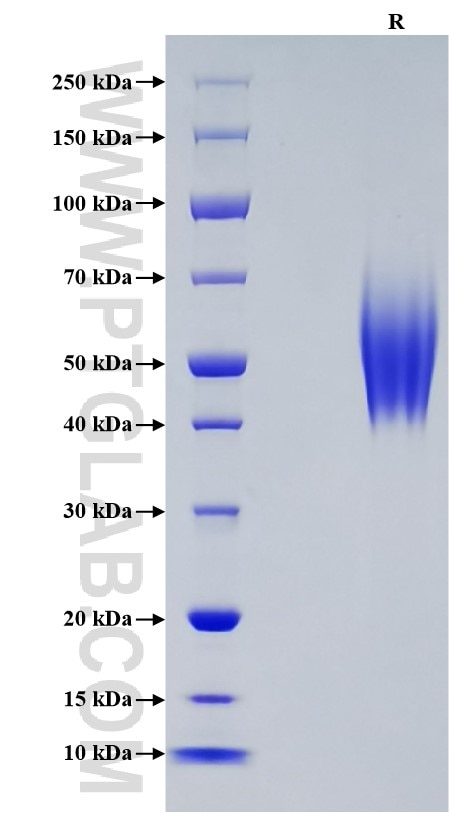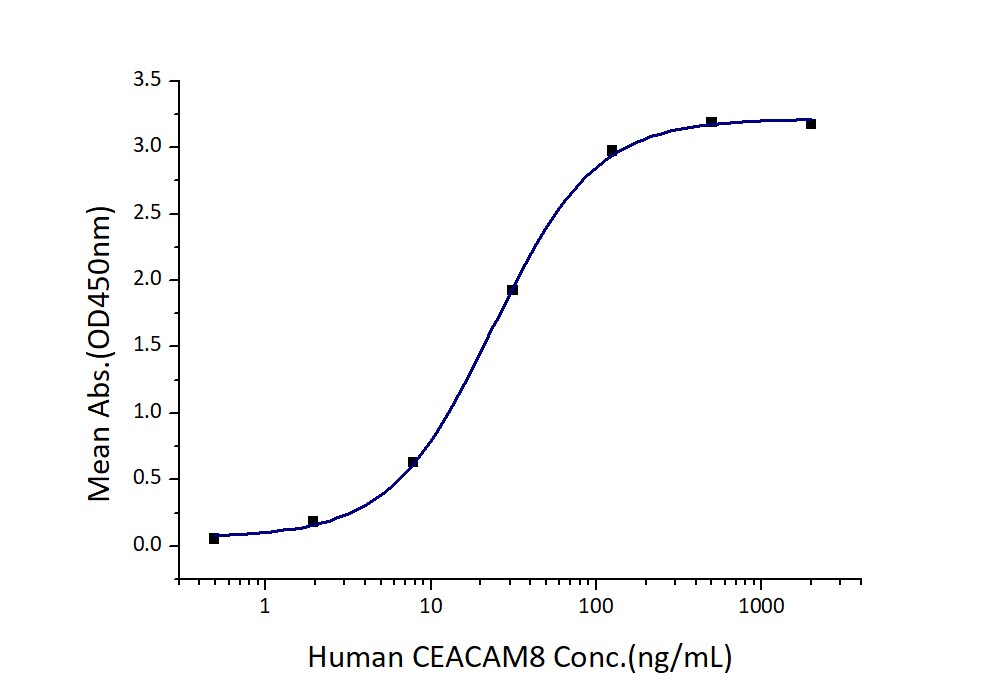Recombinant Human CEACAM6/CD66c protein (Myc Tag, His Tag)(HPLC verified)
Species
Human
Purity
>95 %, SDS-PAGE
>90 %, SEC-HPLC
Tag
Myc Tag, His Tag
Activity
EC50: 12-46 ng/mL
Cat no : Eg0056
Validation Data Gallery
Product Information
| Purity | >95 %, SDS-PAGE >90 %, SEC-HPLC |
| Endotoxin | <0.1 EU/μg protein, LAL method |
| Activity |
Immobilized Human CEACAM-6 (Myc tag, His tag) at 2 μg/mL (100 μL/well) can bind Human CEACAM-8 (hFc tag) with a linear range of 12-46 ng/mL. |
| Expression | HEK293-derived Human CEACAM6 protein Lys35 -Gly320 (Accession# P40199) with a Myc tag and a His tag at the C-terminus. |
| GeneID | 4680 |
| Accession | P40199 |
| PredictedSize | 36.3 kDa |
| SDS-PAGE | 40-70 kDa, reducing (R) conditions |
| Formulation | Lyophilized from 0.22 μm filtered solution in PBS, pH 7.4. Normally 5% trehalose and 5% mannitol are added as protectants before lyophilization. |
| Reconstitution | Briefly centrifuge the tube before opening. Reconstitute at 0.1-0.5 mg/mL in sterile water. |
| Storage Conditions |
It is recommended that the protein be aliquoted for optimal storage. Avoid repeated freeze-thaw cycles.
|
| Shipping | The product is shipped at ambient temperature. Upon receipt, store it immediately at the recommended temperature. |
Background
Carcinoembryonic antigen-related cell adhesion molecule 6 (CEACAM6), belonging to the immunoglobulin superfamily, is cell-adhesion protein on neutrophils. CEACAM6 is expressed in neutrophils and numerous tumor cell lines. CEACAM6 mediates homophilic and heterophilic cell adhesion with other carcinoembryonic antigen-related cell adhesion molecules, such as CEACAM5 and CEACAM8. It plays a role in neutrophil adhesion to cytokine-activated endothelial cells and plays a role as an oncogene by promoting tumor progression; positively regulates cell migration, cell adhesion to endothelial cells and cell invasion. CEACAM6 is also involved in the metastatic cascade process by inducing gain resistance to anoikis of pancreatic adenocarcinoma and colorectal carcinoma cells.
References:
1.Kuroki M, et al. (2001). Journal of leukocyte biology. 70(4): 543-50 2.Kuijpers TW, et al. (1992). J Cell Biol. 118(2):457-66 3.Blumenthal RD, et al. (2005). Cancer research. 65(19):8809–8817 4.Ordoñez C, et al. (2000). Cancer Res. 60(13):3419-24 5.Duxbury MS, et al. (2004). Oncogene. 23(2):465-73



